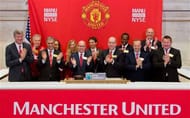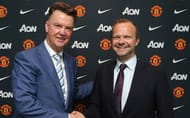NYSE Flotation
In July 2012, United filed an application to sell shares on the New York Stock Exchange (NYSE). Earlier rumours had put the location down as Singapore, especially after approval for listing on the Singapore stock exchange was granted in 2011. It had recently been valued at $2.23 billion by Forbes, making it the most valuable club in sport at the time.
The club aimed at raising around $330 million from the issue. It became public that most of the money would go towards servicing the debt, and a lot of money would go to the Glazers. Furthermore, the shares would not have as much voting power as the ones the Glazers held, and shareholders would not be entitled to regular dividends. This contributed to the reduction of the size of the float, down to $220 million (around 10% of the club).
The situation of debt at the club became significantly better, as accounts published in November 2012 and May 2013 showed the club debt at £360 million and £307 million respectively. The debt was once again refinanced, saving the club £10 million in interest payments per year.
United won the league in the 2010/11 as well as the 2012/13 season and reached Champions League finals in 2009 and 2011. DHL were unveiled as the club’s training kit sponsor, a deal worth £40 million over four years that dwarfed the deals of many Premier League club’s official deals.
Whatever the issues off the field, the Red Devils were still performing well on it. A lot of this was down to the managerial brilliance of Sir Alex Ferguson, whose ability to squeeze the utmost ability out of seemingly ordinary players cannot be overstated. United’s net spend on players was far less than it had been in the past, especially considering the revenues that were coming into the club.
After Ferguson
Sir Alex retired after the 2012/13 season, winning yet another Premier League crown, taking United’s tally to 20 in total. David Moyes was hired as his replacement, with Ed Woodward taking on David Gill’s role as chief executive.
The breakup of the highly successful Ferguson-Gill combination proved disastrous, as David Moyes promptly matched his career achievements at Everton by guiding United to seventh place. Moyes was fired before the end of the season, with Ryan Giggs stepping in as caretaker manager. Louis van Gaal was appointed the manager going into the 2014/15 season on a three-year contract.
Moyes’ failure can also be attributed to Woodward’s unfamiliarity with the workings of the European transfer markets, with Marouane Fellaini being the only signing of the transfer window. Moyes was not given enough to replenish United’s thin and aging squad, and the results that season speak for themselves. This is clearly illustrated after United’s nearly €200 million spree after Louis van Gaal’s arrival and their subsequent Champions League qualification.
Woodward was brilliant at the commercial side of things though, as he took many innovative steps even before his promotion. He developed the idea of regional partners for sponsorships, allowing the club access into many different markets without precluding entry into others. This model is now being adopted by many other clubs.
United sold energy company AON the rights to their training complex and negotiated an early buy-out of the DHL deal, paving the way for the absolutely mammoth shirt sponsorship with General Motors, worth $559 million (£357 million) over seven years. Never before has football seen a sponsorship deal of that magnitude.
Interestingly, General Motors later fired the executive who saw that deal through, prompting questions as to whether GM overpaid. Never the less, the deal remains, and while there were penalties for failure to qualify for the Champions League, Louis van Gaal’s fourth-place finish this past season has put those concerns to bed for the time-being at least.
United also signed a world-record kit deal with adidas, worth £750 million over 10 seasons. At £75 million per season, it dwarfs the next best deal, Bayern Munich’s 15-year deal worth £42.5 million per season (which is also with adidas).
Looking ahead
In 2015, the debt at United was refinanced once again. This deal was far better structured, and while overall debt will rise to £425 million from the current £382 million, with the debts payable in 2027. Most importantly, the debt has an interest rate of only 3.79%, down from 8.375%. The interest rates are fixed and this insulates United from any changes in the market.
The cost of interest has reduced from £20 million per year to just £13 million per year, a sum that is barely an issue for a revenue generating behemoth like United. For context, in 2008, 70% of EBITDA went on interest, but projected figures for 2016 show it to be just under 10%. United also have an astonishing number of sponsors that help them generate massive amounts of commercial revenues.
This means that United can spend figures they were previously associated with spending, as evidenced by last summer’s spree. This summer, they have already completed the signing of Memphis Depay from PSV for £24.2 million and have announced their intent to further bolster the squad.
It’s also worth noting that during the Glazer’s ownership, United have won 9 major trophies (5xPL, 1xUCL, 3xLC), as well as the Club World Cup and 5 Community Shields (that is second only to Chelsea among English clubs in the same time period). The Glazers have definitely not been mindful of fans’ wishes, and merely treated United as a vehicle through which they would make money.
However, looking at the club’s financial history, it seems as though the investment has definitely paid off for them in a financial sense. United seemed to be in a bit of a crisis after Moyes, but the subsequent flexing of financial muscle and re-entry to the Champions League has seemingly righted the course of the club. Re-entry into the Champions League means another £40-60 million in revenue, as calculated here.
United’s revenues mean that they would have no issue complying with UEFA’s FFP regulations either way, but they can no longer rely on the managerial magic that Ferguson used to regularly perform on a relative budget later in his career. The club have seemingly recognised this, and are taking steps to strengthen and replenish the playing squad as well as focussing on improving their commercial activities.
United earned a total of £440 million in 2015, with its commercial revenues up 83% over three years. However, the club also fell to number 3 on Forbes’ list of the most valuable football clubs, at $3.1 billion (behind Real Madrid and Barcelona).
United are now in a position of great strength to kick on and re-establish their dominance of English football. Backed by an experienced manager in Louis van Gaal, the commercial deals set up to provide huge sources of revenue, and unburdened by debt for the first time in a while, the club is certainly in a strong position to challenge for titles in the near future.


